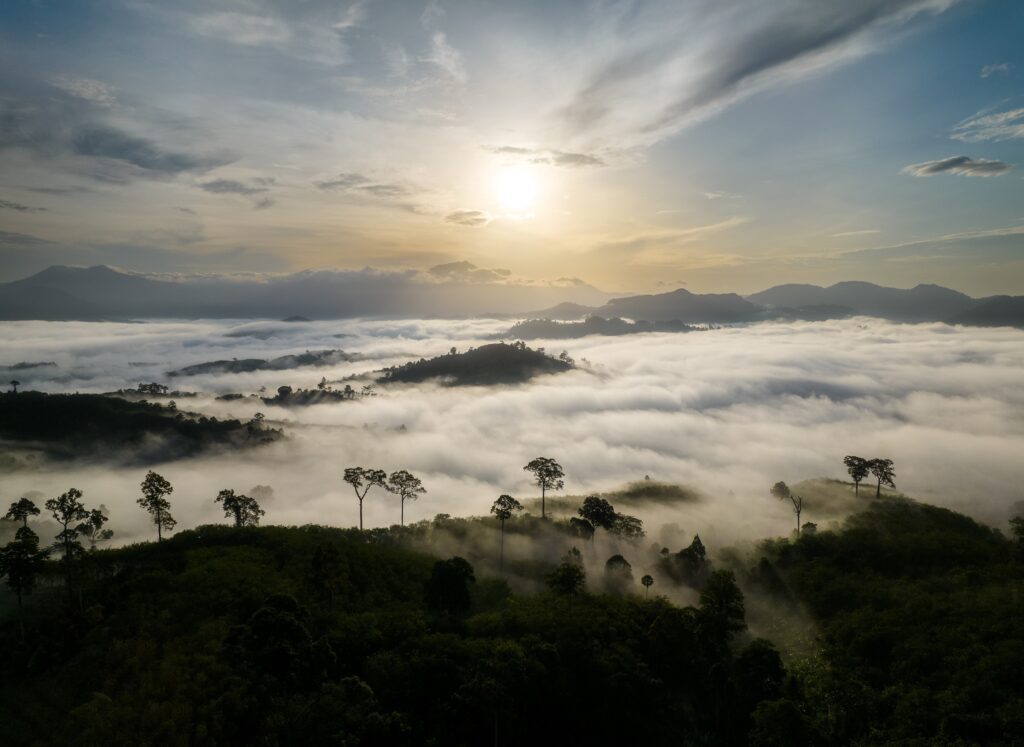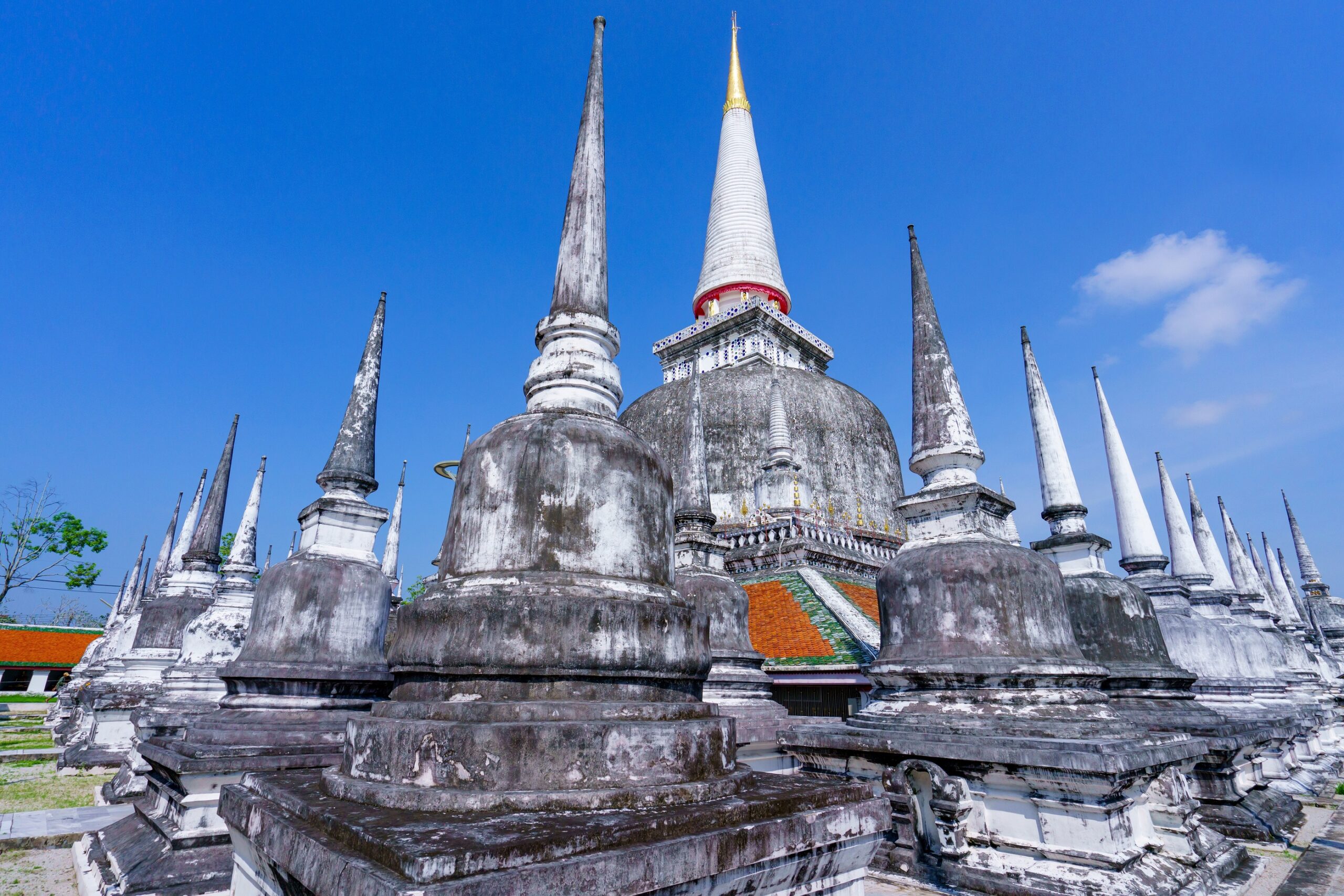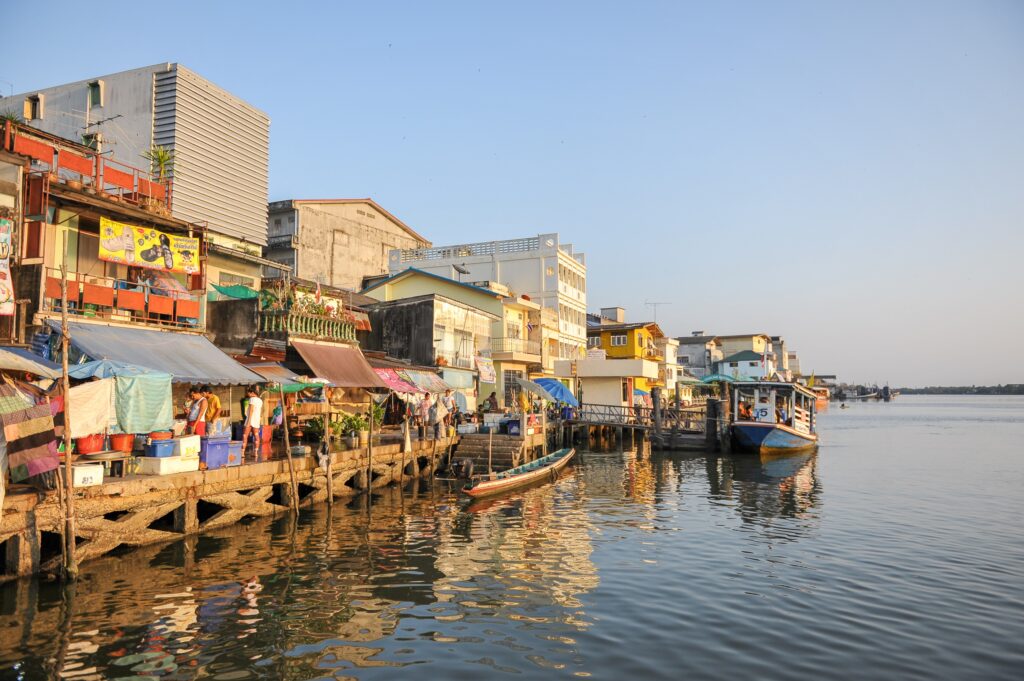
Khao Jang Lone Mountain – Nakhon Si Thammarat
Tucked along the Gulf of Thailand coast, Nakhon Si Thammarat has a unique natural and cultural allure.
For more than 1,000 years, the province has been a hub for those journeying between the South China Sea and the Andaman Sea. The ancient city lured all sorts of travelers from far and near, among them Indian traders, Chinese seafarers, and Islamic clerics, to this part of the Malay Peninsula.
The most important visitors to what is now known as Nakhon Si Thammarat were Buddhist monks from present-day Sri Lanka. They arrived in this port town in the 12th century with the Four Noble Truths of Buddhism. The province was later recognized as a landing place of Theravada Buddhism.
Today, the travel destination is a rewarding stop between Surat Thani and Hat Yai, delighting the visitor with its beautiful temples, stupas, and historical landmarks. But Nakhon Si Thammarat is more than just its past.
The southern province covers 225 kilometers of coastline with beautiful and pristine beaches from the Khanom to Hua Sai districts. With its majestic mountain ranges, rainforest, and small villages in the valley, Khao Luang National Park is the best place for jungle treks and rural retreats.
This diversity is Nakhon Si Thammarat’s real draw: you can explore the legacies of the old town, climb the mountains, and still have time to hit the beaches.
Getting There
Air
Local carriers fly from Bangkok’s Don Mueang International Airport to Nakhon Si Thammarat every day.
Bus
Public buses depart from Bangkok’s Southern Terminal for Nakhon Si Thammarat daily. The journey takes 12 hours.
Train
Two trains run between Bangkok and Nakhon Si Thammarat. The journey takes 15 hours.
Getting Around
Songthaew minibuses and motorcycle taxis are ideal for short rides. Inter-district buses are available for longer trips within the province.
10 Best Things To Do in Nakhon Si Thammarat
Nakhon Si Thammarat offers a wealth of hidden treasures from little-known coconut-fringed beaches and rare pink dolphins swimming off Khanom to remote villages in the valleys.
1. Cherish the beauty of Wat Phra Mahathat

At 77-meters tall, the sacred pagoda at Wat Phra Mahathat Woramahawihan (often known as Wat Phra Mahathat) has been in existence for more than 800 years. The gigantic bell-shaped stupa was commissioned by King Sri Dhammasokaraja to house the Lord Buddha’s relics and establish the symbol of Theravada Buddhism. Inspired by Sri Lankan Buddhist art, the pagoda is best in the cold season. At that time, the white-washed monument with its golden spire casts a spiritual beauty against a heavenly blue sky. If you are in town on the days of Makha Bucha or Asarnha Bucha, you can celebrate the robe-offering ceremony with the local people. The towering stupa, however, is well worth visiting at any time of the year. Most visitors wander around the grounds and snap pictures of the picturesque pagoda from various viewpoints. Every Saturday evening, the temple grounds transform into a night marketplace where you can experience the local colors and savor local fare. Visit here for more information.
2. Savor tasty and traditional breakfast
The classic Nakhon Si Thammarat breakfast is anything from Hainanese-inspired warm toast with a sweet custard and endless sets of dumplings to Muslim-run roti and chicken Biryani to fresh rice noodles in an eye-watering spicy soup. No matter what the locals order for breakfast, they always wash it down with coffee that’s both sweet and bitter. Made from beans sautéed in margarine and sugar, the coffee is thoroughly sweetened. Kopi, a traditional restaurant chain in Nakhon Si Thammarat, serves classic breakfast in heritage “Kopitiam” (coffee shop in Hokkien). The restaurant is well worth visiting for a caffeine kick and to rub shoulders with talkative locals who like nothing more than to gossip around the table. Kopi has many branches all over town, but the original and best is next to the provincial hall.
3. Enjoy a City Wall stroll

No visit to Nakhon Si Thammarat is complete without a walk around the city wall. The first wall to enclose the rectangular city, it was built when the town was founded in the early 13th century. Over time, the walls deteriorated and were restored and strengthened on multiple occasions to keep the enemy at bay. In the middle of the 17th century, the city wall was reconstructed in Chateau style, reflecting the French influence on Siamese architecture. Today only a short stretch of the northern city wall and its gate remains, making for a wonderful stroll in the morning or evening. From a history buff’s point of view, the old city wall is impressive in that it pays testimony to the engineering and construction skills of local people back then.
4. Play with the shadow at Shadow Puppet Museum
Within easy walking distance of Wat Phra Mahathat is the home of Suchart Subsin—a Thai national artist and puppet master. The local artist has transformed his traditional wooden house into a small museum for preserving his collection of shadow puppets and southern craftsmanship. Shadow puppetry is an ancient art form of storytelling and entertainment. Using just light, shadow, and a simple screen, the puppeteers can make the one-dimension cut-out puppets walk, dance, fight, nod, and laugh. Ban Nang Talung, as the museum is known as, draws visitors for its original sets of traditional puppets. It also occasionally holds shadow puppet shows and workshops focusing on subjects like puppet making. Admission is free, but visitors can donate to local artists and craftsmen by buying puppets, T-shirts, and other memorabilia at the souvenir shop.
5. Happy hike in Khao Luang
At 1,835 meters above sea level, Khao Luang is the highest mountain in Thailand’s South. Part of the national park, the high range draws intrepid hikers for a trek over winding mountain ridges and exciting forests. The park is a refuge to over 300 species of orchid species and more than 200 species of birds. Khao Luang hiking trails go to different major peaks, dip into various valleys and meander along waterfalls and creeks. For those who don’t have a week—or the stamina—to explore the entire park, the multi-night trail is broken into smaller, scenic paths. Nature lovers will enjoy trekking along several routes to explore the tropical rainforest.
Getting to Khao Luang National Park:
A songthaew pick-up minibus will take you from Nakhon Si Thammarat to Lan Saka district for around 30 Baht. From there, the driver will take you 10 kilometers further to the park’s headquarters for an extra fee. Private transportation can be arranged by your hotel.
Where to stay and eat:
There is a campground and restaurant in the park. For hiking information, contact Khao Luang National Park.
6. Mud bathing in style
Just 25 kilometers north of downtown Nakhon Si Thammarat, Ban Laem Village is one of the province’s best-kept secrets. The peaceful fishing village has survived on small-scale fishing for centuries thanks to its abundant shoreline. It is now drawing health-conscious visitors for thalassotherapy, a form of therapy that relies on seawater and natural minerals from the seafloor. A study found that seawater and our skin have something in common when it comes to mineral content. By repeatedly soaking up warm seawater, sunlight, ocean breezes, and iodine-laden air, anti-aging sea minerals nourish the skin. Unlike the posh and expensive sea treatments offered elsewhere, thalassotherapy in Ban Laem is fun and an adventure. Visitors take a short boat ride out to the natural mud source before taking a mud bath and rinsing off in the sea. The community provides accommodation in rustic cottages to those who want to experience a rural retreat longer than a day.
Website: Banlaem Homestay
Getting to Ban Laem: Take a songthaew minibus or arrange a private transfer from Nakhon Si Thammarat.
7. Khiriwong for the purest air
Khiriwong village has some of the cleanest air in Thailand. Tucked away in the rainforest valley of Khao Luang National Park, Khiriwong draws in weary visitors from the big cities. The village in the valley, however, has more to share with travelers than the fresh air. Amazing organic fruit orchards and homestays dot the area, where you can reawaken your rural instincts while not forfeiting your comfort. From July to October, the valley is filled with juicy and delicious tropical fruits such as durian, mangosteen, banana, langsat, jackfruit, and rambutan. The mountain scenery is mind-blowing. You can stay in a cottage on stilts perched over the creek, trek along the nature trail crisscrossing fruit gardens, or indulge your talent for crafts by learning organic tie-dyeing techniques. The home-cooked food is fresh, filling, and always served with a smile. Getting to Khiriwong: Take a songthaew pick-up minibus or arrange a private transfer from Nakhon Si Thammarat. Khiriwong is about 30 kilometers west of downtown.
8. Delve into 1,000 years of history in just one hour
Nakhon Si Thammarat National Museum on Rajdamnoen Road is dedicated to people, history, art, and culture in the province and some other places in Thailand’s south. Moving from one room to another allows you to travel through a timeline of Nakhon Si Thammarat’s history. The first exhibition consists of prehistoric artifacts found in the area, suggesting that people lived here 6,500 years ago. The next focuses on the many different faiths—Brahmanism, Mahayana Buddhism, Theravada Buddhism, Christianity, and Islam among them—practiced by the locals, highlighting Nakhon Si Thammarat’s status as a multicultural society. Its permanent collection of Vishnu images, dancing Shivas, and phallic Shiva lingam is striking. There’s also a 9th-century stone Buddha head among several ancient Srivijaya statues. Admission is just 150 Baht ($4.46 USD).
Getting there: Take a songthaew pick-up minibus or motorcycle taxi
9.Visit Khanom beach and interact with pink dolphins

With long pristine beaches punctuated by coconut trees and jungle-clad mountains, Khanom is a terrific destination— and that’s before even interacting with rare pink dolphins. Not too far from the Khanom coast is an area home to 50 pink dolphins. Also known as the Indo-Pacific humpbacked dolphin (Sousa Chinensis), the newborns are dark grey. As they grow up, their skin changes to white and pink to help prevent their body temperature from getting too high. Seeing pink dolphins in their natural habitat should be on everyone’s bucket list. Watching the gentle creatures dip in and out of the water with barely a splash is captivating. As they swim alongside the boat and interact with humans, they demonstrate their docile and charming natures. The “humpback of Khanom” can be spotted from October to May. A long-tailed boat regularly runs from Laem Prathap in the morning out to the bay for pink dolphin watching. The trip takes about two hours.
Getting to Khanom: Minibuses depart from the Nakhon Si Thammarat Bus Terminal to Khanom every 40 minutes from 5am to 4pm. The journey takes 90 minutes. The fare is 80 Baht.
10. Feast your eyes (and belly) at Pak Phanang

About 40 kilometers east of downtown Nakhon Si Thammarat, Pak Phanang district made headlines in 1962 when tropical storm Harriet wiped out the Talumpuk Cape. Today, serenity has returned, and the small coastal town is now making news for its natural beauty and cuisine. Every Sunday afternoon, the riverside community transforms its canal into a “Retro Marketplace,” selling a wide variety of food. The old food market and riverside communities are the places to go if you want to rub shoulders with the locals. The merchants of Pak Phanang ply their trade in fresh and dried seafood. You can walk along the towpath, watch fishing boats coming in and going out, or take a boat trip and enjoy Pak Phanang’s scenic riverfront. The long and idyllic Talumpuk beach is now dotted with local restaurants where you can try deep-fried king mackerel, barbequed cuttlefish, sensational seafood soup, and more without worrying about the price.
Getting to Pak Phanang: Take a songthaew pick-up minibus or arrange a private transfer from Nakhon Si Thammarat.


